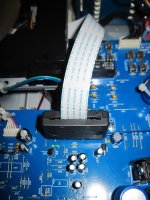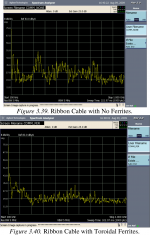Hello,
just tested that if I add a ferrite core onto the flat flex cable connecting the laser unit with the big printed circuit board, I get slight better sound (more precise soundstage and better bass).
Any scientific reason why, or is just a random performance (could be positive or negative depending on the machine) or just a placebo effect of my ears?
just tested that if I add a ferrite core onto the flat flex cable connecting the laser unit with the big printed circuit board, I get slight better sound (more precise soundstage and better bass).
Any scientific reason why, or is just a random performance (could be positive or negative depending on the machine) or just a placebo effect of my ears?
Attachments
Last edited:
What were you trying to accomplish, and what rationale did you use that would lead you to expect it would work? It is exceedingly rare for a random idea that someone decides to try actually does anything at all, much less make any real improvement.
My vote is that you are experiencing the fruits of expectation bias, i.e., placebo effect.
Mike
My vote is that you are experiencing the fruits of expectation bias, i.e., placebo effect.
Mike
below are images taken from techmasters the cable is longer and there are other differences.
As the signal from the laser is rf you might be removing some noise or stopping some being radiated by the cable? can you view the eye-pattern with a scope?
What you might want to try something like rtlsdr-analyzer-from-dvb-t-tuner/ and maybe see if there is a difference, you might need an antenna just search diy emc antenna or probe.
emc_testing1
regards
james
As the signal from the laser is rf you might be removing some noise or stopping some being radiated by the cable? can you view the eye-pattern with a scope?
What you might want to try something like rtlsdr-analyzer-from-dvb-t-tuner/ and maybe see if there is a difference, you might need an antenna just search diy emc antenna or probe.
emc_testing1
regards
james
Attachments
To my knowledge, cables coming from the laser to the mainboard carry currents, not voltage.
(This was differnt with many models up to the nineties,
where head amps were mounted on the laser do amplify the current to a stable voltage signal. One common example is KSS-240
But nobody seems to do this today any more)
I once tested to shield a current-carrying cable from the laser to the head amp and got almost no signal at all.
Discs were not playable. I assume the shielding caused to produce voltage, like a resistor. Frankly I do not know wether a ferrite has the same effect.
Maybe someone might give an explanation if a ferrite core has an effect on currents at all...
(This was differnt with many models up to the nineties,
where head amps were mounted on the laser do amplify the current to a stable voltage signal. One common example is KSS-240
But nobody seems to do this today any more)
I once tested to shield a current-carrying cable from the laser to the head amp and got almost no signal at all.
Discs were not playable. I assume the shielding caused to produce voltage, like a resistor. Frankly I do not know wether a ferrite has the same effect.
Maybe someone might give an explanation if a ferrite core has an effect on currents at all...
Last edited:
How can shielding a signal cause such a signal degradation? rather strange or you were doing something wrong....
What a ferrite will do in this instance is attenuate high frequency common mode noise, common practice in many areas of electronics...
Without any measurements it is impossible to tell whether it is having an effect or whether it is a placebo effect...
What a ferrite will do in this instance is attenuate high frequency common mode noise, common practice in many areas of electronics...
Without any measurements it is impossible to tell whether it is having an effect or whether it is a placebo effect...
Ferrite around a cable only interacts with currents, not voltages. It adds HF impedance for common-mode currents. This may or may not be a good thing, depending as always on context.Salar said:Maybe someone might give an explanation if a ferrite core has an effect on currents at all...
Thank you for the interest.
Yes the flex cable is higly sensitive (when you touch it the player stops or starts to rotate at incredible velocity...)
FYI the sourse chip is CXA2581.
I have no professional equipment but the effect of a ferrite on a flat cable are very clear in the above graphs and I hope mine could be the same case too.
Yes the flex cable is higly sensitive (when you touch it the player stops or starts to rotate at incredible velocity...)
FYI the sourse chip is CXA2581.
I have no professional equipment but the effect of a ferrite on a flat cable are very clear in the above graphs and I hope mine could be the same case too.
It is not placebo what you hear.
Ferrite can make a effect on your cables, doesn't matter if these are power, signal or digital ones.
In my diy speaker cables I prefer ferrite core on the positive run wire as close to speaker as possible.
Different placing of ferrite changes (lowes) the effect.
Trust your ears and have open mind, please.
Wysłane z mojego iPhone przez Tapatalk
Ferrite can make a effect on your cables, doesn't matter if these are power, signal or digital ones.
In my diy speaker cables I prefer ferrite core on the positive run wire as close to speaker as possible.
Different placing of ferrite changes (lowes) the effect.
Trust your ears and have open mind, please.
Wysłane z mojego iPhone przez Tapatalk
- Status
- This old topic is closed. If you want to reopen this topic, contact a moderator using the "Report Post" button.
- Home
- Source & Line
- Digital Source
- CdPlayer Mod:ferrite on the flat cable connecting the laser unit with the board PCB

